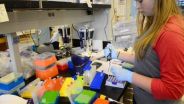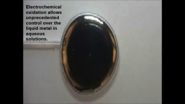(Press-News.org) COLUMBIA, Mo. – According to recent studies, approximately one out of every 40 individuals in the United States is a carrier of the gene responsible for spinal muscular atrophy (SMA), a neurodegenerative disease that causes muscles to weaken over time. Now, researchers at the University of Missouri have made a recent breakthrough with the development of a new compound found to be highly effective in animal models of the disease. In April, a patent was filed for the compound for use in SMA.
"The strategy our lab is using to fight SMA is to 'repress the repressor,'" said Chris Lorson, a researcher in the Bond Life Sciences Center and professor in the MU Department of Veterinary Pathobiology. "It's a lot like reading a book, but in this case, the final chapter of the book—or the final exon of the genetic sequence—is omitted. The exciting part is that the important chapter is still there—and can be tricked into being read correctly, if you know how. The new SMA therapeutic compound, an antisense oligonucleotide, repairs expression of the gene affected by the disease."
In individuals affected by SMA, the spinal motor neuron-1 (SMN1) gene is mutated and lacks the ability to process a key protein that helps muscle neurons function. Muscles in the lower extremities are usually affected first, followed by muscles in the upper extremities, including areas around the neck and spine.
Fortunately, humans have a nearly identical copy gene called SMN2. Lorson's drug targets that specific genetic sequence and allows proper "editing" of the SMN2 gene. The drug allows the SMN2 gene to bypass the defective gene and process the protein that helps the muscle neurons function.
Lorson's breakthrough therapeutic compound was patented in April. His research found that the earlier the treatment can be administered in mice with SMA, the better the outcome. In mice studies, the drug improved the survival rate by 500 to 700 percent, with a 90 percent improvement demonstrated in severe SMA cases, according to the study.
Although there is no cure for SMA currently, the National Institutes of Health (NIH) has listed SMA as the neurological disease closest to finding a cure, due in part to effective drugs like the one developed in Lorson's lab.
INFORMATION:
Lorson's study, "Morpholino antisense oligonucleotides targeting intronic repressor Element1 improve phenotype in SMA mouse models," was published in September 2014 in the Journal of Human Molecular Genetics. Graduate student Erkan Osman was the lead author. The study was funded by a grant from the National Institutes of Health, a training grant and a fellowship from the Howard Hughes Medical Institute.
Researcher develops and proves effectiveness of new drug for spinal muscular atrophy
2014-09-15
ELSE PRESS RELEASES FROM THIS DATE:
EEG study findings reveal how fear is processed in the brain
2014-09-15
DALLAS, TX – September 12, 2014 - An estimated 8% of Americans will suffer from post traumatic stress disorder (PTSD) at some point during their lifetime. Brought on by an overwhelming or stressful event or events, PTSD is the result of altered chemistry and physiology of the brain. Understanding how threat is processed in a normal brain versus one altered by PTSD is essential to developing effective interventions.
New research from the Center for BrainHealth at The University of Texas at Dallas published online today in Brain and Cognition illustrates how fear arises ...
Smithsonian scientists discover tropical tree microbiome in Panama
2014-09-15
Human skin and gut microbes influence processes from digestion to disease resistance. Despite the fact that tropical forests are the most biodiverse terrestrial ecosystems on the planet, more is known about belly-button bacteria than bacteria on trees in the tropics. Smithsonian scientists and colleagues working on Panama's Barro Colorado Island discovered that small leaf samples from a single tree were home to more than 400 different kinds of bacteria. The combined sample from 57 tree species contained more than 7,000 different kinds.
Bacteria in tropical forests may ...
Scientists discover RNA modifications in some unexpected places
2014-09-15
CAMBRIDGE, Mass. (September 15, 2014) – The so-called central dogma of molecular biology—that DNA makes RNA which makes protein—has long provided a simplified explanation for how genetic information is deciphered and translated in living organisms.
In reality, of course, the process is vastly more complicated than the schema first articulated nearly 60 years ago by Nobel Laureate Francis Crick, co-discoverer of the DNA's double-helix structure. For one, there are multiple types of RNA, three of which—messenger RNA (mRNA), transfer RNA (tRNA), and ribosomal RNA (rRNA)—are ...
Study first to use brain scans to forecast early reading difficulties
2014-09-15
UC San Francisco researchers have used brain scans to predict how young children learn to read, giving clinicians a possible tool to spot children with dyslexia and other reading difficulties before they experience reading challenges.
In the United States, children usually learn to read for the first time in kindergarten and become proficient readers by third grade, according to the authors. In the study, researchers examined brain scans of 38 kindergarteners as they were learning to read formally at school and tracked their white matter development until third grade. ...
'Femme fatale' emerald ash borer decoy lures and kills males
2014-09-15
An international team of researchers has designed decoys that mimic female emerald ash borer beetles and successfully entice male emerald ash borers to land on them in an attempt to mate, only to be electrocuted and killed by high-voltage current.
"Our new decoy and electrocution process may be useful in managing what the U.S. Department of Agriculture Forest Service claims to be the most destructive forest pest ever seen in North America," said Michael Domingue, postdoctoral fellow in entomology, Penn State.
According to the Forest Service, the emerald ash borer was ...
Researchers control surface tension to manipulate liquid metals
2014-09-15
VIDEO:
Liquid metals have very large surface tensions that causes them to assume a spherical shape. Researchers have shown that the deposition of a surface oxide lowers the surface tension...
Click here for more information.
Researchers from North Carolina State University have developed a technique for controlling the surface tension of liquid metals by applying very low voltages, opening the door to a new generation of reconfigurable electronic circuits, antennas and other ...
Neuroscientists identify key role of language gene
2014-09-15
CAMBRIDGE, MA -- Neuroscientists have found that a gene mutation that arose more than half a million years ago may be key to humans' unique ability to produce and understand speech.
Researchers from MIT and several European universities have shown that the human version of a gene called Foxp2 makes it easier to transform new experiences into routine procedures. When they engineered mice to express humanized Foxp2, the mice learned to run a maze much more quickly than normal mice.
The findings suggest that Foxp2 may help humans with a key component of learning language ...
Network measures predict neuropsychological outcome after brain injury
2014-09-15
Cognitive neuroscience research has shown that certain brain regions are associated with specific cognitive abilities, such as language, naming, and decision-making.
How and where these specific abilities are integrated in the brain to support complex cognition is still under investigation. However, researchers at the University of Iowa and Washington University in St. Louis, Missouri, believe that several hub regions may be especially important for the brain to function as an integrated network.
In research published online Sept. 15 in the Early Edition of the Proceedings ...
Cells simply avoid chromosome confusion
2014-09-15
Reproductive cell division has evolved a simple, mechanical solution to avoid chromosome sorting errors, researchers report in the Sept. 11 Science Express.
This natural safeguard prevents incorrect chromosome counts and misalignments that lead to infertility, miscarriage, or congenital conditions.
"Mistakes during reproductive cell division cause these problems, but what exactly goes wrong is often not understood," said Adele Marston of the Wellcome Trust Center for Cell Biology at the University of Edinburgh in Scotland and lead author of the study. Understanding ...
NASA's TRMM satellite sees Hurricane Odile strike Baja California
2014-09-15
VIDEO:
This animation of NOAA's GOES-West satellite imagery from Sept. 13 through Sept. 15 shows Hurricane Odile's movement and landfall near Cabo San Lucas on Mexico's Baja California. TRT 0:42...
Click here for more information.
NASA's Tropical Rainfall Measuring Mission satellite known as TRMM captured data on powerful Hurricane Odile revealing heavy rainfall from powerful thunderstorms as it made landfall in Baja California. Odile tied a record for strongest hurricane to hit ...





